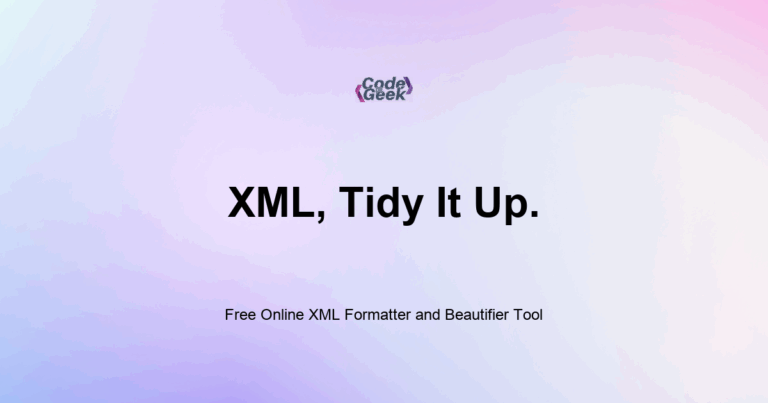XML Formatter
Format and beautify your XML code with proper indentation and structure
What is an Online XML Formatter?
An XML formatter, also known as an XML beautifier or XML pretty printer, is a specialized tool designed to transform poorly formatted or minified XML code into a clean, readable format. Our free online XML formatter automatically adds proper indentation, line breaks, and spacing to make your XML documents easier to read, debug, and maintain.
XML (eXtensible Markup Language) is a markup language that defines rules for encoding documents in a format that is both human-readable and machine-readable. However, XML files often become compressed, minified, or poorly formatted, making them difficult to work with. This is where an XML formatter becomes invaluable.
What Does Our XML Formatter Do?
Our XML formatter tool provides several key functionalities:
- Automatic Formatting: Instantly transforms unformatted XML into properly structured code with consistent indentation and line breaks.
- Real-time Processing: Format your XML code instantly without any delays or processing time.
- Preserve Content Integrity: The tool only modifies formatting while preserving all your original XML content, attributes, and structure.
- Error Detection: Identifies basic XML syntax errors and provides helpful error messages when invalid XML is detected.
- Statistics Display: Shows useful metrics including line count, character count, and element count after formatting.
Cross-platform Compatibility: Works seamlessly across all modern web browsers and devices without requiring any downloads or installations.
What to Expect When Using This Tool
When you use our XML formatter, here’s what you can expect:
- Immediate Results: Simply paste your XML code into the input area and click “Format XML” to see instant results in the output section.
- Clean Interface: The side-by-side layout allows you to easily compare your original XML with the formatted version.
- Helpful Feedback: The tool provides success messages and error notifications to guide you through the formatting process.
- Mobile-Friendly Design: The responsive interface works perfectly on desktop computers, tablets, and mobile devices.
- No Data Storage: Your XML content is processed entirely in your browser and never stored on our servers, ensuring complete privacy and security.
Common Use Cases for XML Formatting
Web Development
- API Response Debugging: Format XML responses from web services and APIs for easier debugging and analysis
- Configuration Files: Clean up XML configuration files for applications, frameworks, and content management systems
- SOAP Web Services: Format SOAP XML messages for better readability during development and testing
Data Processing
- Data Migration: Format XML data files when transferring information between different systems
- Database Exports: Clean up XML exports from databases before importing into other applications
- ETL Processes: Format XML data during extract, transform, and load operations
Content Management
- RSS Feeds: Format RSS and Atom feeds for easier editing and validation
- Sitemap Optimization: Clean up XML sitemaps for better search engine optimization
- Content Syndication: Format XML content feeds for distribution across multiple platforms
Software Development
- Code Review: Format XML configuration files and data structures for team code reviews
- Documentation: Create readable XML examples for technical documentation and tutorials
- Testing: Format XML test data and mock responses for automated testing frameworks
System Administration
- Configuration Management: Format XML configuration files for servers, applications, and network devices
- Log Analysis: Clean up XML log files for easier parsing and analysis
- Backup Verification: Format XML backup files to verify data integrity and structure
Input and Output Examples
Example 1: Basic XML Structure
Input (Unformatted):
<users><user id="1"><name>John Doe</name><email>[email protected]</email><active>true</active></user><user id="2"><name>Jane Smith</name><email>[email protected]</email><active>false</active></user></users>
Output (Formatted):
<users>
<user id="1">
<name>John Doe</name>
<email>[email protected]</email>
<active>true</active>
</user>
<user id="2">
<name>Jane Smith</name>
<email>[email protected]</email>
<active>false</active>
</user>
</users>
Example 2: RSS Feed Format
Input (Compressed):
<rss version="2.0"><channel><title>Tech Blog</title><description>Latest technology news</description><item><title>AI Advances</title><description>New developments in artificial intelligence</description><pubDate>Mon, 06 Jan 2025 10:00:00 GMT</pubDate></item></channel></rss>
Output (Formatted):
<rss version="2.0">
<channel>
<title>Tech Blog</title>
<description>Latest technology news</description>
<item>
<title>AI Advances</title>
<description>New developments in artificial intelligence</description>
<pubDate>Mon, 06 Jan 2025 10:00:00 GMT</pubDate>
</item>
</channel>
</rss>
Example 3: Configuration File
Input (Minified):
<config><database><host>localhost</host><port>3306</port><username>admin</username></database><logging><level>info</level><file>/var/log/app.log</file></logging></config>
Output (Formatted):
<config>
<database>
<host>localhost</host>
<port>3306</port>
<username>admin</username>
</database>
<logging>
<level>info</level>
<file>/var/log/app.log</file>
</logging>
</config>
Frequently Asked Questions (FAQs)
Is this XML formatter free to use?
Yes, our XML formatter is completely free to use with no limitations on the number of times you can format XML code or the size of your XML files.
Do you store my XML data?
No, we do not store any of your XML data. All formatting is performed entirely in your browser using client-side JavaScript, ensuring your data remains private and secure.
What is the maximum file size I can format?
While there’s no strict file size limit, very large XML files (over 1MB) may take longer to process depending on your device’s performance. For optimal performance, we recommend formatting files under 500KB.
Can this tool validate XML syntax?
Our formatter includes basic XML syntax validation and will display error messages if invalid XML is detected. However, for comprehensive XML schema validation, you may need specialized validation tools.
Does the formatter work offline?
Once the page is loaded, the XML formatter works entirely in your browser and doesn’t require an internet connection to format XML code.
Can I format XML with namespaces?
Yes, our formatter fully supports XML with namespaces and will preserve all namespace declarations and prefixes during formatting.
What happens if my XML contains special characters?
The formatter preserves all special characters, Unicode content, and CDATA sections exactly as they appear in your original XML.
Can I undo the formatting?
Use the “Clear All” button to reset both input and output areas, then paste your original XML again if needed.
Does the tool work on mobile devices?
Yes, our XML formatter is fully responsive and works on all modern mobile devices and tablets.
What XML standards does this tool support?
Our formatter supports XML 1.0 and XML 1.1 standards and is compatible with various XML-based formats including RSS, SOAP, SVG, and custom XML schemas.
Can I format XML with comments?
Yes, the formatter preserves XML comments and positions them appropriately in the formatted output.
How accurate is the element count in the statistics?
The element count shows the number of opening XML tags in your document, providing a quick overview of your XML structure complexity.
Benefits of Using Formatted XML
Improved Readability: Well-formatted XML is significantly easier to read and understand, making debugging and maintenance much more efficient.
Better Collaboration: Formatted XML facilitates better team collaboration by ensuring consistent code style across projects.
Easier Debugging: Proper indentation and structure make it easier to identify XML syntax errors and logical issues.
Enhanced Documentation: Formatted XML serves as better documentation and is more suitable for code examples and tutorials.
Faster Development: Clean, readable XML reduces development time and helps prevent errors during manual editing.
Best Practices for XML Formatting
When working with XML, following these best practices will help you maintain clean, professional code:
- Consistent Indentation: Use consistent spacing (typically 2 or 4 spaces) for each nesting level
- Meaningful Element Names: Choose descriptive names for XML elements and attributes
- Proper Nesting: Ensure all XML elements are properly nested and closed
- Attribute Quotes: Always use quotes around attribute values
- Comment Usage: Add comments to explain complex XML structures
- Validation: Regularly validate your XML against relevant schemas or DTDs
Getting Started
Using our XML formatter is simple:
- Paste Your XML: Copy your unformatted XML code and paste it into the “XML Input” area
- Click Format: Press the “Format XML” button to process your code
- View Results: See the formatted XML appear in the “Formatted Output” area
- Copy Results: Copy the formatted XML for use in your projects
- Clear When Done: Use “Clear All” to reset the tool for your next formatting task
Start formatting your XML code now and experience the difference that proper formatting makes in your development workflow!

